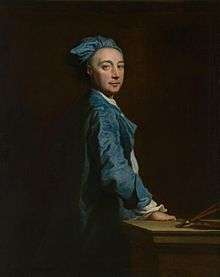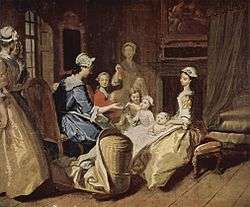Joseph Highmore
| Joseph Highmore | |
|---|---|
 Self-Portrait ca. 1745/47, National Gallery of Victoria | |
| Born |
13 June 1692 London |
| Died | 3 March 1780 (aged 87) |
| Nationality | British |
| Known for | Portrait painting |
| Spouse(s) | Susanna Highmore |
Joseph Highmore (13 June 1692 – 3 March 1780) was an English portrait and historical painter, illustrator and author.
Life
Highmore was born in London, the third son of Edward Highmore, a coal merchant, and nephew of Thomas Highmore, Serjeant Painter to William III. He displayed early ability but was discouraged by his family from taking up art professionally, and began a legal training instead. At the ending of a clerkship at the age of 17, however, he abandoned the law and started to work as a painter.[1]
On the revival of the Order of the Bath in 1725, he was selected to paint the knights in full costume. The years 1732 to 1734 were spent on a tour of the Netherlands and France.[1] In the next few years he received patronage from the royal family, but during the 1740s began to cater more for a middle-class clients.[2] In 1762 Highmore sold the contents of his studio and retired to Canterbury, where he lived with his daughter and son-in-law.[2]
Highmore died aged 87 on 3 March 1780.[1] He was buried in sheep's wool (to comply with a 17th-century statute to encourage the wool trade) in the fifth bay of the south aisle of Canterbury Cathedral.[1]
Family
His wife Susanna Highmore (née Hiller) was a poet, though little of her work was published. His son Anthony Highmore (1719–99) was an artist, one of whose 15 children, Anthony Highmore Jnr. (1758–1829), became a writer on legal affairs and a social activist.[1]
Works

In addition to his work as a portraitist, Highmore painted works illustrating biblical subjects, historical painting being a style which Highmore had picked up on his travels in France.[1] One such biblical painting is Hagar and Ishmael, which Highmore donated to the Foundling Hospital for the purpose of decorating its Court Room.[1] The painting is now part of the Foundling Hospital art collection at the Foundling Museum in London.[1][3]
In 1744, Highmore painted a series of 12 illustrations to Samuel Richardson's Pamela, or Virtue Rewarded, which were engraved by Benoist and Louis Truchy.[1]
As an author, he was best known for the works Critical Examination of Reubens' two Paintings in the Banqueting House and Observations on Bodwell's Pamphlet against Christianity.[1]
See also
- Hubert-François Gravelot (also provided illustrations for an earlier, 1742 edition, of Richardson's Pamela).
References
| Wikimedia Commons has media related to Joseph Highmore. |
- Attribution
 This article incorporates text from a publication now in the public domain: Cust, Lionel Henry (1891). "Highmore, Joseph". In Lee, Sidney. Dictionary of National Biography. 26. London: Smith, Elder & Co.
This article incorporates text from a publication now in the public domain: Cust, Lionel Henry (1891). "Highmore, Joseph". In Lee, Sidney. Dictionary of National Biography. 26. London: Smith, Elder & Co.
External links
- Joseph Highmore online (Artcyclopedia)
- Joseph Highmore on Artnet
- Prominent artists in "Pamela" (University of Michigan)